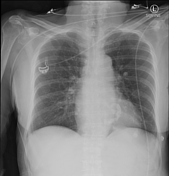2,345 results found
Article
Upper lobe pulmonary venous diversion
Upper lobe pulmonary venous diversion (also described as cephalisation of the pulmonary veins) reflects elevation of left atrial pressure and is an early sign of pulmonary edema.
Clinical presentation
The normal left atrial pressure is 5-10 mmHg. An elevation of left atrial pressure to 10-15 m...
Case
Post-partum cardiomyopathy

Published
19 Jan 2022
75% complete
X-ray
Case
Anteroseptal hypokinesia after myocardial infarction

Published
30 Nov 2011
94% complete
MRI
Article
Myocardium
The myocardium defines the middle layer of the cardiac wall between the endocardium and the pericardium and forms the muscular part of the heart.
Gross anatomy
The myocardium represents the middle layer of the cardiac wall. It is located between the endocardium and the epicardial layer of the ...
Case
Atrial septal defect

Published
26 Feb 2015
83% complete
CT
Case
Left atrial enlargement

Published
04 Dec 2023
79% complete
X-ray
Article
Lutembacher syndrome
Lutembacher syndrome refers to the rare combination of congenital atrial septal defect with acquired mitral stenosis.
History and etymology
It is named after Rene Lutembacher 4.
Case
Atrial septal defect

Published
24 May 2009
54% complete
X-ray
Question
Question 776
Which of the following causes inferior rib notching?
Question
Question 1646
Which one is not the COVID-19 pneumonia?
Question
Question 873
Which of the following muscles is generally spared radiologically in Duchenne muscular dystrophy?
Question
Question 1059
Which label identifies the left atrium?
Article
Conotruncal cardiac anomalies
Conotruncal heart defects are a group of congenital cardiovascular anomalies involving the outflow tracts and great vessels. They are a leading cause of symptomatic cyanotic cardiac disease diagnosed in utero.
Epidemiology
They may account for up to a fifth of all congenital cardiac anomalies ...
Question
Question 1852
All the following factors are considered as risk factors for cholelithiasis EXCEPT...
Article
Epipericardial fat necrosis
Epipericardial fat necrosis (also sometimes purely categorized as pericardial fat necrosis or epicardial fat necrosis) is a rare self-limiting cause of acute pleuritic pain in an otherwise healthy individual, without fever or cough. It occurs external to the pericardium.
Clinical presentation
...
Article
Peripartum/postpartum cardiomyopathy
Peripartum/postpartum cardiomyopathy is a dilated cardiomyopathy that may occur in the last trimester of pregnancy through the first several months postpartum.
Epidemiology
The estimated incidence in the United States ranges from one in 900 to one in 4000 live births, with an increased inciden...
Question
Question 197
The true lumen of an aortic dissection is often...
Article
Mitral annular calcification
Mitral annular calcification refers to the deposition of calcium (along with lipid) in the annular fibrosa of the mitral valve.
Epidemiology
Annular calcification is seen in up to 35% of elderly patients. It is common in females over 65 years, in those with myxomatous degeneration of the mitra...
Question
Question 198
The most appropriate first-line modality for the diagnosis of aortic dissections is...
Question
Question 196
Which of the following statements are FALSE?
Stanford type A aortic dissections...









 Unable to process the form. Check for errors and try again.
Unable to process the form. Check for errors and try again.